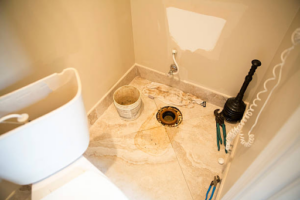As a homeowner, one of the most important pieces of equipment in your home is your toilet. It’s important to make sure that everything is in good working order so you don’t have any nasty surprises (or worse, a plumbing emergency).
A toilet flange is a vital part of your plumbing system. This is the piece that connects your toilet to the drain pipes in the floor. From there, the waste is deposited into the bowl of the toilet where they are then flushed away with water.
Types of Toilet Flanges
When it comes to your toilet, there are a lot of necessary components – one of which is the toilet flange.
Here are the three most common types of toilet flanges:
- Copper
Copper is corrosion-resistant and can withstand high temperatures, making it ideal for this application.
- PVC (Plastic)
PVC is durable, easy to work with, and resistant to corrosion. It’s increasingly popular because they are easier to install than traditional cast iron flanges.
- Cast Iron
Cast Iron toilet flanges are a common and sturdy choice for many homeowners. It is durable and works with almost any plumbing system. Plus, cast iron flanges can also be painted to match your bathroom décor.
- Brass
Brass is a strong, durable material that can withstand heavy use without corroding like some other materials. It provides a secure seal between the toilet and the drain pipe, preventing leaks and ensuring proper drainage.
- Stainless Steel
Stainless steel flanges are more durable than traditional plastic or metal flanges and can withstand more wear and tear. They’re also less likely to corrode, making them a better choice for humid environments.
- Aluminum
Aluminum is often used for the wax ring of toilet flanges, but some flanges are made entirely of aluminum. It can be more resistant to corrosion than other metals. Additionally, aluminum is a more affordable option than stainless steel or brass flanges.
Toilet Flange Shapes & Sizes
The three primary shapes that are used in the design of a toilet flange are:
Regular
Regular toilet flange is a round, metal plate or plastic that sits around the drain hole in your floor and the bolt holes are pre-drilled in it with a standard size pipe.
Deep Seal
Deep seal flanges are designed to create a tighter seal between the toilet and the drain pipe, which can help prevent leaks and other problems. This type of flange is available in two styles: one with a rubber gasket and one with an adjustable metal band.
Offset
Offset flanges are used to correct for misalignment between the drain pipe and the toilet. Offset toilet flange accommodates wider pipes. It is installed on top of the drain pipe and it has a hole in the middle that lines up with the hole in the bottom of the toilet.
When To Replace Toilet Flange?
It’s a question that plumbers get asked all the time: “When do I need to replace my toilet flange?” The answer, of course, depends on the situation. The average lifespan of a toilet flange is about 10 years. But in general, you’ll want to replace your toilet flange when it starts to show signs of wear and tear. Leaks, cracks, and corrosion are all indicative that it’s time for a replacement.
Call Tap 2 Drain
If you notice a leak or corrosion, it may be time to replace your toilet flange. With so many types out there, you might not be sure where to start. Our team at Tap 2 Drain Plumbing Services can help! Contact us today to keep your plumbing system running efficiently!


